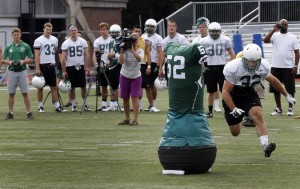For my last Civic Issues blog, I thought it would be a good idea to bring the topic closer to home, with a discussion about concussions and Penn State athletes, accompanied by a brief review of the of the movie, Concussion. Penn State’s Center for Sport Concussion Research in the College of Health and Human Development is home to a state of the art facility studying traumatic brain injury in collegiate and pediatric athletics. In this facility, resides the innovative PSU Virtual Reality Concussion Lab. “The Virtual Reality (VR) lab is designed to examine residual cognitive and motor abnormalities in patients suffering from a concussion.” The lab employs unique “assessments that involve virtual reality and feature realistic 3D computer generated environments that enable the athlete to feel fully immersed in cyber-imagery. The participant wears a special headset and stands on a platform in front of a 12′ x 10′ screen, then navigates with a joystick through a simulation of hallways and rooms, a 3D elevator, and more.” To assess the status of an injury, an athlete will complete these same tests pre and post-concussion, so doctors have a basis for comparison. VR allows doctors in the lab to observe the patient’s brain activity second by second to see if there are any abnormalities. These virtual reality assessment techniques are then combined with the examination of brain imaging scans, like MRIs and EEGs to evaluate the changes in brain functions and structures to more accurately diagnose and evaluate concussions.
Penn State’s Director of Athletic Medicine and multiple staff doctors work closely with all of the university’s men’s and women’s athletic teams to evaluate athletes for potential concussions and determine the course of action using the resources available in the Center. These more innovative and evolving assessment techniques are important to the health of student athletes to prevent short and long term damage, especially when it is evident that single and even more so, multiple concussions may lead to brain damage. New research and evaluation techniques used in Penn State’s Center for Sport Concussion Research over the past few years is timely, since this topic is regularly in the news, especially with the recent release of the movie, Concussion, which follows Dr. Bennet Omalu’s discoveries of the effects of concussions and traumatic brain injury.
I finally was able to watch Concussion after waiting many months for it to be available to rent.  As a huge football fan and having played the sport from the time I was eleven years old until my senior year of high school, I am now even more thankful that I never received a more serious head injury other than one minor concussion. Concussion really opened my eyes to the severity of this type of brain injury and the potential long-term impact of multiple concussions, causing chronic traumatic encephalopathy (CTE), a degenerative brain disease that can eventually lead to difficulty with thinking, emotions and behaviors. After finding definitive consistent abnormalities in the brains of athletes, Dr. Omalu pursues further research. He describes how a human’s brain is not built to withstand constant hits to the head, as he contrasts what happens to other animals accustomed to hitting their heads. He represents a human head by shaking an egg inside of a jar to show how there are no shock absorbers around the brain. This is in comparison to a woodpecker with a brain that is wrapped around its tongue, which is also around its skill and through its nostrils, all acting as an incredible shock absorber. Dr. Omalu’s primary research was based on former professional football players, even though he was not familiar with American football. Alarmed with his findings, Dr. Omalu confronted many obstacles as he tried to find a receptive audience with the NFL.
As a huge football fan and having played the sport from the time I was eleven years old until my senior year of high school, I am now even more thankful that I never received a more serious head injury other than one minor concussion. Concussion really opened my eyes to the severity of this type of brain injury and the potential long-term impact of multiple concussions, causing chronic traumatic encephalopathy (CTE), a degenerative brain disease that can eventually lead to difficulty with thinking, emotions and behaviors. After finding definitive consistent abnormalities in the brains of athletes, Dr. Omalu pursues further research. He describes how a human’s brain is not built to withstand constant hits to the head, as he contrasts what happens to other animals accustomed to hitting their heads. He represents a human head by shaking an egg inside of a jar to show how there are no shock absorbers around the brain. This is in comparison to a woodpecker with a brain that is wrapped around its tongue, which is also around its skill and through its nostrils, all acting as an incredible shock absorber. Dr. Omalu’s primary research was based on former professional football players, even though he was not familiar with American football. Alarmed with his findings, Dr. Omalu confronted many obstacles as he tried to find a receptive audience with the NFL.
Now I don’t want to have any spoilers in this blog, since I know some of you are football fans and may want to see this movie. Whether you are a football fan or not, an athlete playing any sport or a parent with children in sports, I definitely recommend seeing the movie, Concussion. Once you do, think about how it may have enlightened you too or even just changed your view on how to treat a potential concussion.
One last note… As concussion effects are more widely researched and understood, more professional athletes of differing ages from a variety of sports, including football, soccer, tennis and even a NASCAR driver, are now donating their brains to research to further advance these efforts.











